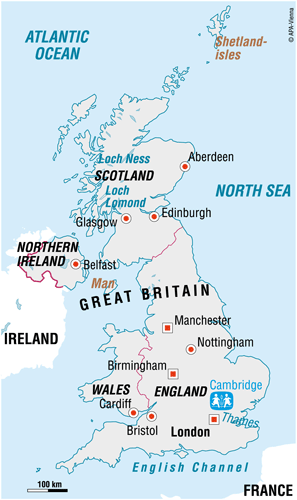
Vi er i United Kingdom
Some facts about the UK
The United Kingdom of Great Britain and Northern Ireland is an island state in the north-west of Europe, with the Isle of Wight, Orkney Islands, Shetland Islands and the Hebrides also being a part of the country's territory. The United Kingdom shares its only land border with the Republic of Ireland.
The total population is 62.7 million and the capital city of London is home to about 8.6 million. The UK is one of the most densely populated nations in the world. Its population is diverse: 92 per cent of the population is white (83.6% are English, 8.6% Scottish, 2.9% Irish, 4.9% Welsh) while the rest of the population reflects the United Kingdom's colonial and immigration history with people of Black African and Black Caribbean, Indian and Pakistani origin. One of the most recent trends is the arrival of people from the new European Union (EU) member states of Central and Eastern Europe. The official language is English, 19% of the Welsh population speaks Welsh, with 60,000 Scots using Gaelic, especially in the Hebrides.
In 1999, the country saw a shift in the legislative structure when the Scottish Parliament in Edinburgh and the National Assembly of Wales in Cardiff were formed. The Northern Ireland Assembly was formed as a result of the Good Friday Agreement of 1998. The United Kingdom is a founding member of NATO and the Commonwealth and a member of the European Union.
Austerity measures after the 2008-2009 global economic crisis
The United Kingdom is one of the largest economies in Europe. The service industry, in particular insurance and banking, accounts for most of the gross domestic product (GDP) and employs 80 per cent of the population. Industry employs about a fifth of the population, but has a declining importance. Although agriculture is a small sector, employing less than two per cent of the working population, it is very intensive and manages to produce about 60 per cent of the food needed.
In 2008, the economy was badly affected by the global crisis and the government introduced measures to counter the negative effects. In 2010, the budget deficit was 11 per cent and the unemployment rate stood at nearly eight per cent.
In 2008/2009, over a fifth of the population, that is 13.5 million people, were living under the nationally-established poverty line. In other words, they were living on 60 per cent or less of the average British household income. Although there is free and universal access to health care, health inequalities associated with class, income or deprivation are pervasive.
Situation of the children in the UK
There are over 13 million children under the age of 18 living in the United Kingdom. In a UNICEF international study on child well-being carried out in 2007, the United Kingdom ranked last among 21 industrialised countries.
The number of children living in low-income households was 3.9 million in 2008/2009. Children are more likely to live in deprivation than adults. Policies to improve the standard of living for UK children have been effective in reducing this number, but the UK still has a higher proportion than any other EU country of children living in households where both parents are unemployed.
Education is compulsory between the ages of 5 and 16, but the Education and Skills Act 2008 raised it to the age of 18 as from 2013. In 2010, a quarter of young adults between the ages of 16 and 24 were not working. One in ten 16-to-18-year olds is not in employment, education or training.
SOS Children's Villages in the UK
SOS Children's Villages UK is particularly well suited to internet fundraising. Funds raised have helped the association take full responsibility for the construction and running costs of SOS Children's Villages in Basse, The Gambia, and in Chipata, Zambia. In addition to online and face-to-face activities, SOS Children's Villages UK run an annual fundraising campaign called 'World Orphan Week', during which everyone is invited to raise money by 'wearing something WOW' for one day in exchange for a donation.